Isola Sacra - Central north part - Basilica of Saint Hippolytus [5] and Campanile [6]
This church was built at the site of the tomb of the martyr Hippolytus, who died in Portus. In the Acta Sanctorum his martyrdom is intertwined with that of Aurea, who died in Ostia in the second half of the third century.
|
Eodem die hoc audiens beatus Ypolytus, qui etiam Nonnus vocatur, obtulit se in conspectu Romuli, et ita voce clara dixit: O miser, si scires, non cruciares cervices Sanctorum, et te ipsum humiliares Deo et Domino Iesu Christo, et servires ei, et non lapidibus vanis. Iratus Romulus praecepit, ut manibus et pedibus ligaretur, et vivus in fovea mergeretur. Tunc beatus Ypolitus episcopus, elevans oculos ad caelum dixit: Domine Iesu, rex regum et Dominus dominantium, gratias ago tibi ego peccator, quia dignatus es me famulum tuum in loco mundo inter aquas coronare. Te deprecor Filium Dei summi, suscipe spiritum meum: et dum mersus fuisset in foveam ante muros Urbis, iuxta alveum Tyberis, audita est vox quasi infantium per unius horae spatium, dicentium, Deo gratias. Romulus dixit: Hoc insaniam magicae artis cognosco. Ecce nunc audistis consolationes daemonum. Tunc Christiani occulte noctu levaverunt corpus de puteo cum hymnis et Dei laudibus, cum omni diligentia sepelierunt in eodem loco, non longe ab ipso puteo, sed quasi pedes plus minus sexaginta, sub die decimo Kalendas Septembris. [Elsewhere the place of the burial is specified as follows] in eodem loco non longe ab ipsa fovea, quasi pedes plus minus sexaginta in insula, quae uno latere mare habet, a duobus divisione alvei Tyberis cingitur, vigesima secunda die mensis Augusti. |
On that same day the blessed Hypolytus (who is also called Nonnus), hearing this, offered himself before Romulus and spoke in a distinguished voice: "Wretched man, if you knew, you wouldn't torture the necks of the holy men and you would humble yourself before God and the lord Jesus Christ and you would serve him and not these empty stones." Romulus, angered, instructed him to be bound in his hands and feet and while still live, to be buried in a pit. Then, blessed Hypolytus the bishop, raising his eyes to heaven, said, "Lord Jesus, king of kings and lord of all rulers, I, a sinner, thank you, since you have deemed it worthy to crown me as your servant in this worldly place surrounded by the waters. I pray to you, son of the highest God, receive my spirit." And after he had been sunk into the pit in front of the walls of the city, next to the bank of the Tiber, his voice, like that of children praising God, was heard for the course of an hour. Romulus said, "I recognize in this man the madness of magic. See, now you have heard the consolations of the demons." Then the Christians, under the cover of night, with hymns and praises to God dug up his body from that pit and with every care they buried him in that same place, not far from the pit itself but approximately sixty feet (more or less) from there on the tenth day before the Kalends of September [23 August]. [Elsewhere the place of the burial is specified as follows] in that same place, not far from the pit itself, approximately sixty feet (more or less) on the island, which has the sea on one side, and is surrounded by a fork of two branches of the bed of the Tiber, on the 22nd day of the month August. |
| Acta Sanctorum, Martyrdom of Aurea. Translation Douglas Boin. | |
The place was visited in the late 16th century by Cesare Baronio ("Baronius"), who saw the pit and remarked that the church was in ruins after frequent incursions by pirates (Annales Ecclesiastici, t. II, 229 AD nr. VI). The excavations of the basilica, led by Pasquale Testini, began in 1970. Further excavations were conducted in 1993 by Lidia Paroli.
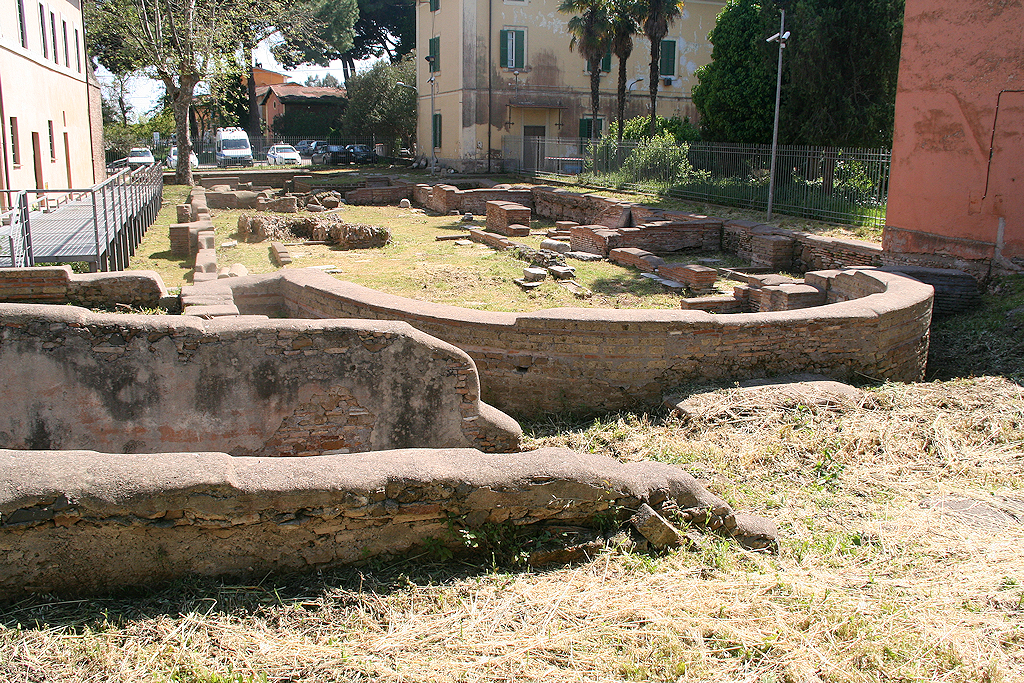
The ruins of the basilica. Photo: Jan Theo Bakker.
Before the basilica was built, the area was occupied by baths, and later by tombs. The oldest Christian building on the site seems to have been a hall with an apse, with the orientation of the later basilica. According to Testini it was built in the second half of the fourth century, most likely on the tomb of one or more martyrs. It was superseded by a basilica measuring 37 x 18 meters. This building had three naves, separated by two rows of 11 columns, partly reused. The central nave was terminated by a semicircular apse. A round baptismal font was added later in the centre of the western nave, and walls were set between the columns.
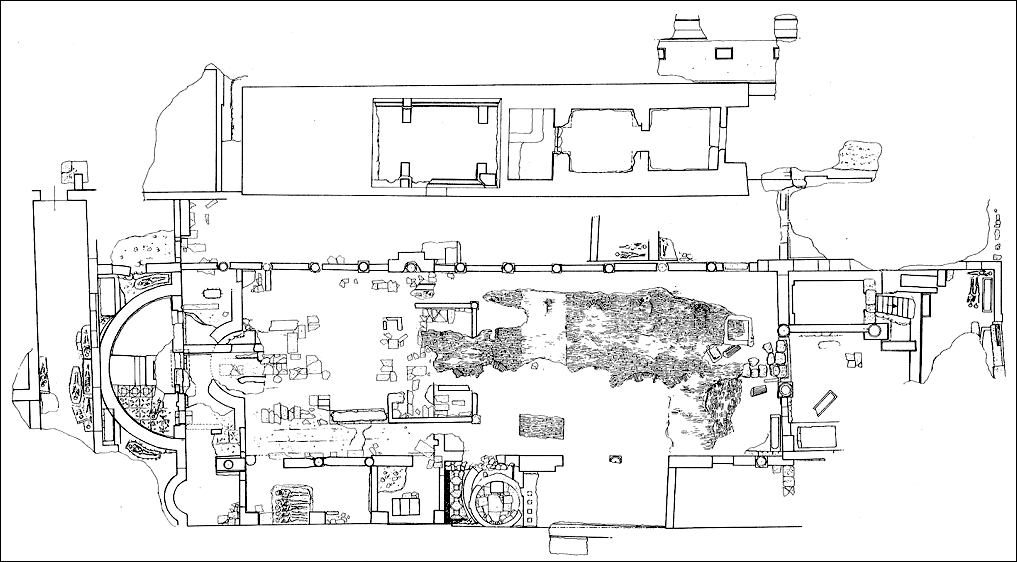
Plan of the basilica. North is to the left. The smaller older apse can be seen to the right of the large apse.
Adapted from Fiocchi Nicolai 2015, Tav. IV.
An inscription mentions the construction of the basilica by bishop Heraclida of Portus:
 |
|
|
HERACLIDA EPISC(opus) SERVVS DEI BASILICAM YPPOLITO [beatissimo martyri fecit?] |
Bishop Heraclida, servant of God, made the basilica for Hippolytus, [most blessed martyr?] |
| EDCS-08600072; EDR078453. Photo: EDCS. | |
The same bishop Heraclida is probably mentioned in an inscription of silver letters in a bronze plaque, suspended from a chain and a ring, bought in Rome around 1870:
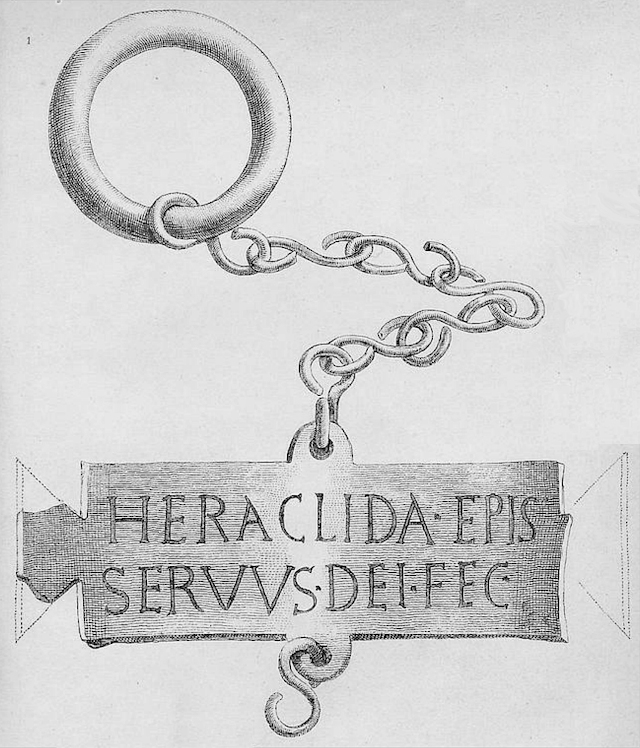 |
|
| Bronze plaque bought in Rome. De Rossi 1871. Image: De Rossi 1871, Tav. V. | |
Scholars agree that Heraclida was active in the late fourth or early fifth century, but disagree about the building (or rather building phase) for which he was responsible. According to Testini he erected the building with three naves, whereas Vincenzo Fiocchi Nicolai prefers a later date for that building, between 450 and 550 AD, linking the work of Heraclida to the oldest Christian building with a single nave.
There is a further complication. In 455 AD Gaeseric, king of the Vandals and Alans, sacked Portus. This has been deduced from an inscription that was found on the Isola Sacra, and informs us that the Vandals burned an aula, a hall, of a martyr. It has been suggested that this was the basilica of Saint Hippolytus, but this is by no means certain. Anyway, the destroyed building was restored by Petrus, a bishop of Portus, of whom we know that he was present at a synod in 465 AD:
|
✝ VANDALICA RABIES HANC VSSIT MARTYRIS AVLAM QVAM PETRVS ANTISTES CVLTV MELIORE NOVATA(m) |
✝ The fury of the Vandals burned down this hall of a martyr, which bishop Petrus renovated with greater refinement. |
| Lost inscription found on the Isola Sacra. CIL XIV Suppl., p. 743; EDCS-42600206. | |
Around 800 AD the basilica received donations from bishop Stephanus and pope Leo III, and half a century later from pope Leo IV. At the end of the ninth century Formosus, bishop of Portus, transferred the remains of Hippolytus and those of two other martyrs, Taurinus and Herculanus, to the church San Giovanni Calibita on the Tiber Island in Rome, as documented by an inscription in the latter church. In a document from 1018 AD the church and surrounding land is established as the Episcopium, the seat of the bishop of Portus.
More confusion is caused by the discovery of human remains in the church. Below the altar a strigilated sarcophagus from the third or fourth century was found, containing the bones of five individuals and a slab with the inscription Hic requiescit Ypolitus mar(tyr). Painted coats of arms point to a date in the 12th century for the reuse of the sarcophagus. It remains puzzling how this can be reconciled with the transfer of the martyr's remains to Rome in the ninth century.
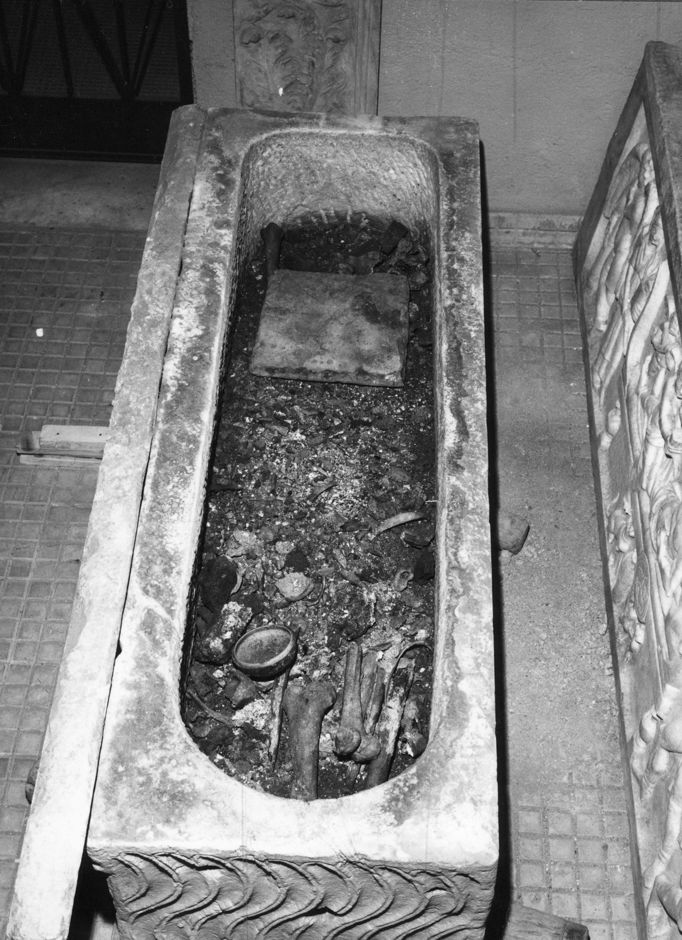
The sarcophagus with the human remains and the inscription. Photo: ICCD N018857.

|
|
|
HIC REQVI ESCIT BEA TVS YPOLI TVS MAR(tyr) |
Here rests the blessed Hippolytus, martyr |
|
The inscription that was found in the sarcophagus. EDR075985. Photo: Parco Archeologico di Ostia Antica. |
|
The campanile of the basilica may have been added in the 12th century. Already in the 15th century the church was in ruins, and it was never rebuilt. For a long time the campanile was the only indication of the former presence of a church. Next to it are now a small memorial chapel, supposedly on the spot of the pit in which Hippolytus died, and an antiquarium.
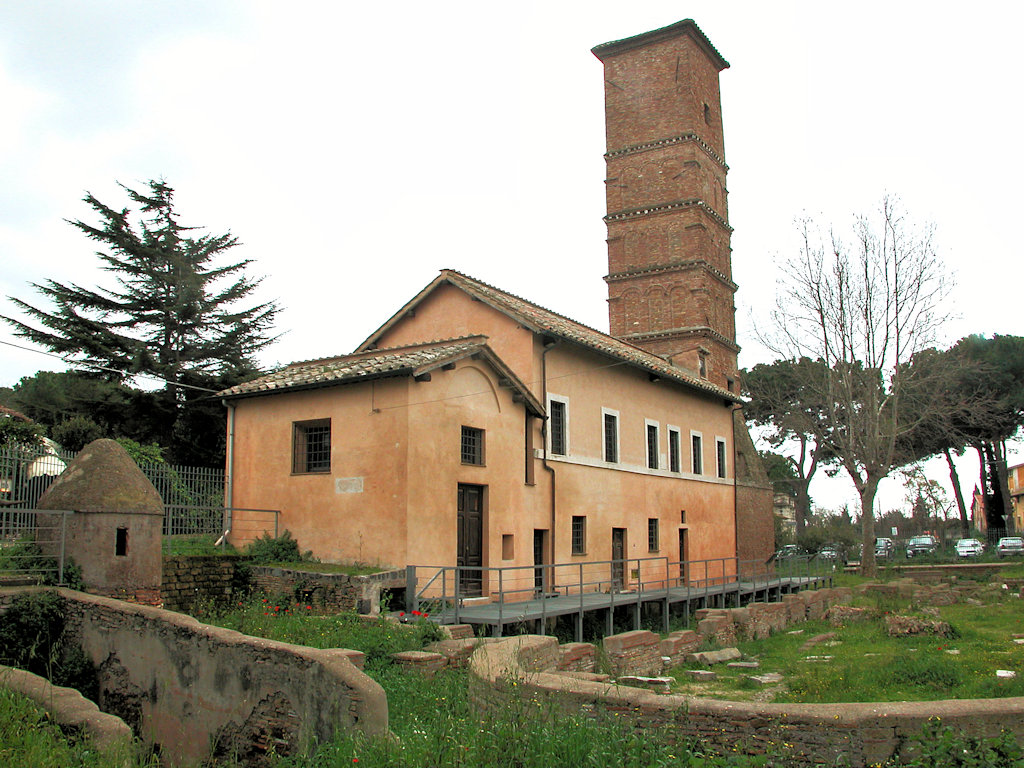
The campanile next to the ruins of the Basilica of Hippolytus. Photo: Parco Archeologico di Ostia.
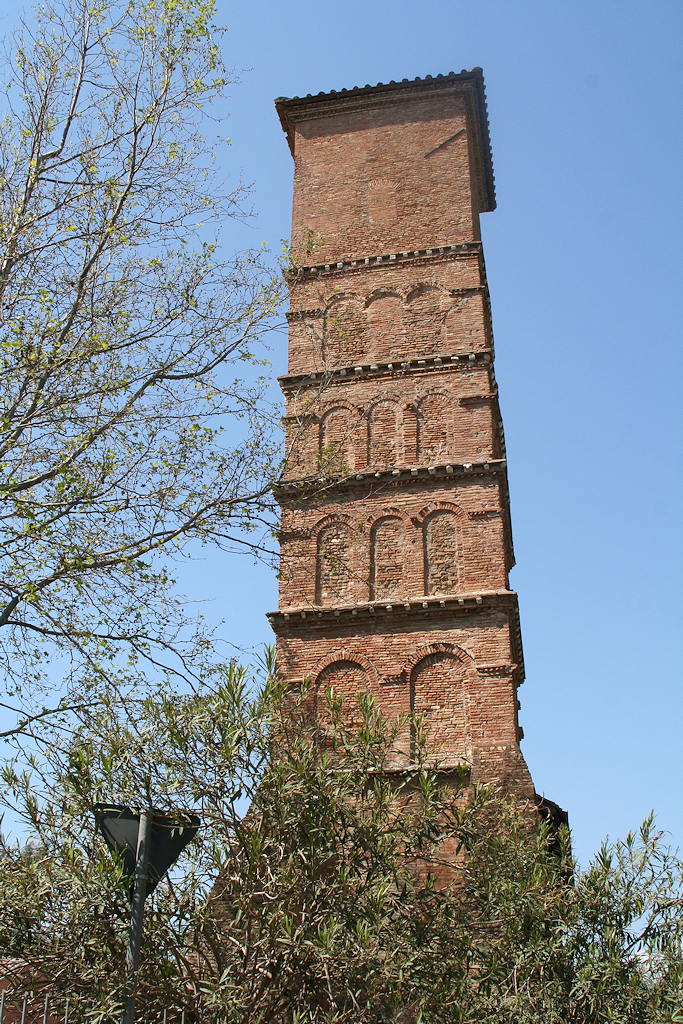
Photo: Jan Theo Bakker.